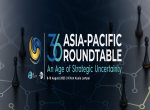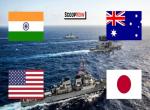2010 marks two decades of India’s engagement with East Asia in the current phase under the rubric the Look East policy that was launched in 1990. It came about in the wake of the end of the cold war, on one hand, and one of the severest crises the Indian economy ever faced, on the other. It has since come a long way to symbolise one of the most important foreign policy initiatives of India has embarked upon in the recent past. At a time when sceptics were beginning to wonder if the Look East policy was losing steam even while China gallops spreading its economic and military influence in the East Asian region, a series of high-level visits and some vital agreements underscored that it is well on its course making significant strides. In fact, the overall environment in the region could not have been more propitious for New Delhi to thrust itself as a key stabilising force in the current state of political uncertainty.
The year 2010 marks the strengthening of economic links-- regarded the weakest when compared to the other great powers-- with a flurry of activity either by way of launch of negotiations or finalisation of trade and economic cooperation agreements. The trade in goods part of the India-ASEAN framework agreement came into effect from 1 January 2010 consequent its finalisation in 2009 after considerable rancour. With that India-ASEAN bilateral trade is expected to reach US$ 50 billion this year compared to about 40 bn. last year. However, India is expected to reap major benefits once the rest of the framework deal comprising services and investment sectors are concluded. India-South Korea Comprehensive Partnership Agreement that was clinched in 2009 also became operational in early 2010. India and Malaysia entered into a broad-based trade opening agreement in October 2010. Similarly, India and Japan have also finalised the Comprehensive Economic Partnership Agreement (CEPA) during Indian Prime Minister Manmohan Singh’s visit in the same month (the actual signing had to be postponed for technical and legal reasons). Simultaneously, India has also started talks on similar deals with most other countries of Asia-Pacific, including Australia, New Zealand, Indonesia, Vietnam, etc. And even China is keen for such a deal. As far as India is concerned, trade with East Asia is growing the fastest compared any other region and current indications suggest that pace is likely to gather steam in the coming years once the present and future economic cooperation agreement come into fruition thus enhancing the criticality of the East Asian region.
From a regional security standpoint, 2010 may turn out to be a high point, for India has emerged probably for the first time in the last couple of centuries as a key player in regional affairs. Aided by some high-profile bilateral visits to and from East Asia, growing concerns about the future of regional order, American resolve to come “back in Asia”, and some diplomatic goof ups by Beijing, New Delhi is now an inalienable part of East Asia. Not least in this calculus are India’s stellar performance as the second fastest growing economy and China’s aggressive assertiveness reflected in a series of incidents in the South China Sea, Yellow Sea, and East China Sea. Equally significant had been America’s increasing wariness about China’s growing assertiveness and its ability to undermine its interests in East Asia, which has prompted it to undertake concerted efforts to regain its predominant position.
2010 will be remembered for a long time, for a series of incidents wreaked havoc in Northeast Asia. It began in March with the sinking of South Korean corvette Cheonan purportedly by a North Korean torpedo resulting in the loss of some 46 lives that rattled both South Korea and Japan. Then in November Pyongyang shocked the world by unveiling a large new uranium enrichment site to the visiting former Los Alamos National Laboratory Director Siegfried Hecker. Just a few days later, North Koreans took everyone by surprise by shelling the South Korean Yeonpyeong Island which brought the two Koreas to the brink of war. China-US war of words reached a crescendo when the former took serious objection to South Korean-US naval exercises in the Yellow Sea close to its territorial waters. Equally significant was the incident involving a Chinese fishing trawler that rammed Japanese coastguard ships that were patrolling the islands of Senkaku, which are under Japanese control but China also has laid claims on. What otherwise could have passed off one of those myriad incidents in this area, it snowballed into a major bilateral crisis even as Beijing aggressively reacted insisting on the unconditional release of the detained captain of the ship along with an apology. Besides repudiating repeated requests to meet the Japanese Prime Minister Naoto Kan on the sidelines of some of the multilateral meetings, China even imposed severe restrictions on the export of rare earth metals to Japan (although informally lest it would violate WTO rules). Although Tokyo relented, the issue has left Japanese flabbergasted, to an extent even helpless in the face of rise of China as a behemoth. It ensued in two important developments: one, the discussion on the relocation of US base facilities in Okinawa abruptly came to an end providing temporary respite, and two the new Japanese National Defence Program Guidelines approved by the Cabinet clearly spelt out the threat China (and North Korea) posed and the need to fundamentally reorient its armed forces. If taken to their logical conclusions, the Guidelines are likely to usher in a Japan that becomes strategically increasingly more autonomous—meaning militarily more robust. Since the Six-Party Talks created to deal with the North Korean nuclear impasse is tottering and in the absence of a tangible mechanisms to tide over bilateral issues either between Japan and China or the US and China, Northeast Asia is going to be in a state of uneasy peace for a while to come.
In Southeast Asia, the issues the figured most prominently were American assertion that it was an Asian power and that its presence would be more robust and Chinese contention for the first time the disputed but geostrategicaly vital islands in the South China Sea constituted its “core interests” on par with Taiwan and Tibet and announcing its inalienable sovereignty over these. Chinese claim engendered ASEAN to run for American security cover leading to not only Washington appointing a fulltime ambassador to ASEAN but even launch US-ASEAN security consultations. America also showed its interest to participate in regional multilateralism, in particular the East Asia Summit starting from 2011.
The above developments have yielded two significant outcomes. One, China’s so called ‘charm offensive’ took a severe beating with its actions, and two India’s overall relevance to the region increased enormously. It is not for nothing that President Obama exhorted India not just ‘look east’ but ‘engage east’. Some signs of regional power balance taking shape apart, India is likely to emerge as a crucial player provided it plays its cards skilfully. As noted, more high-level visits took place in 2010 with East Asia than any other region indicating New Delhi’s fast growing stakes and concomitantly the willingness to play a larger role.
The visit by Malaysian Prime Minister Abdul Razak’s in mid-January 2010 put behind several problems that bilateral relations had faced especially during Mahathir Mohamad’s reign and began a new era. Not surprisingly, Prime Minister Manmohan Singh reciprocated by a three-day visit in the same year in October which resulted in some important agreements on defence and economic cooperation, including the Framework for the India-Malaysia Strategic Partnership. Close on the heels of Razak came South Korean President Lee Myung-bak as the chief guest on the Republic Day, signalling South Korea’s growing economic clout in India. Besides several agreements on economic cooperation, both also agreed to cooperate on civilian nuclear field, start a bilateral security dialogue, and establish a “strategic partnership.” The G-20 Seoul Summit offered yet another opportunity for Singh and Lee to engage in bilateral parleys on the sidelines. A successful spiritual-cum-official visit by Myanmar’s strongman Than Shwe (accompanied by a huge contingent of ministers and officials) in late July 2010 once again underscored huge progress that New Delhi has made in improving its relations with its strategically located neighbour. Japan has emerged as the most important country for India in East Asia and Singh’s October visit as part of the annual summit meeting resulted in further consolidating of an already flourishing bilateral relationship. Prime Minister also made a trip to Vietnam for bilateral meetings as well as to participate in the Eight ASEAN-India Summit and other ASEAN meetings in October. And 2010 ended with Chinese Premier Wen Jiabao in December accompanied by 400-strong businessmen. It turned out to be significant in many respects: most importantly, Beijing for the first time acknowledged that India is an Asian great power (not just as South Asian that it used to parrot), and that there is enough room for both China and India to grow and peacefully co-exist.
True, India today is in a much better position than it had ever been both in terms of its role and status as well as its ability to influence developments in East Asia; events in 2010 are testimony to this. Nevertheless, everything is not hunky dory and there are serious hurdles that New Delhi will have find ways to overcome. Perhaps most significant is the relationship with China as Wen’s visit testified: while the overall relationship has become more mature, certain sharp differences have come to light. Secondly, the much anticipated nuclear deal with Japan to be clinched by the time Prime Minister Singh went to Tokyo failed to materialise indicating problems it is fraught with. Thirdly, despite all the hype about India entering into various economic cooperation agreements with East Asians, it is still not a major player both in trade and investments. Finally, India has obviously not been very successfully in leveraging its strengths—from IT to soft power (even the famous Nalanda project was Singapore’s initiative), which could enhanced its profile. Yet, 2010 augured well for India and may prove to be a turning point insofar as its engagement with East Asia is concerned.
-------------------------------------------
Published Date : 11 January, 2011


_resources1_16a085412ba_large.jpg)






Post new comment